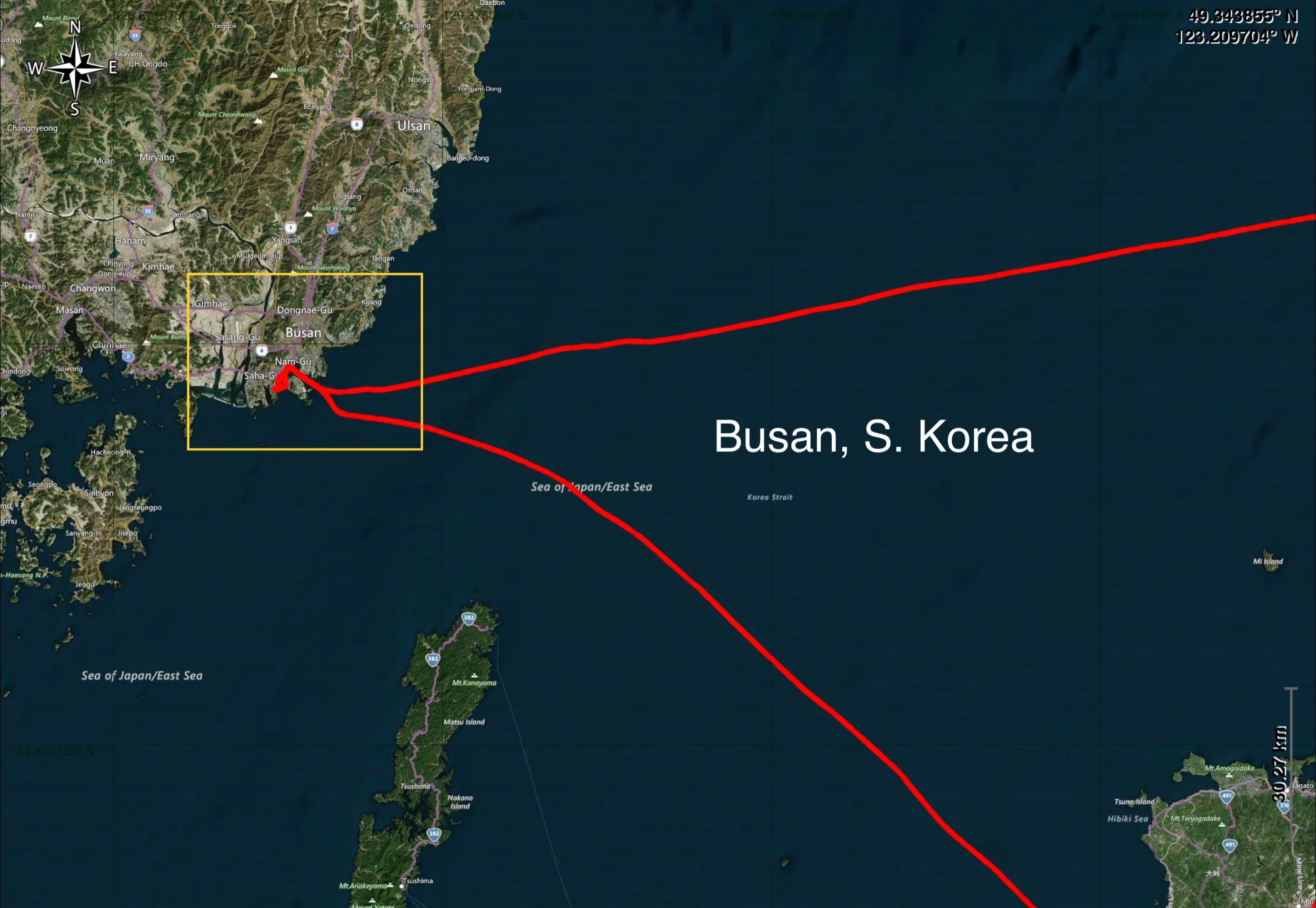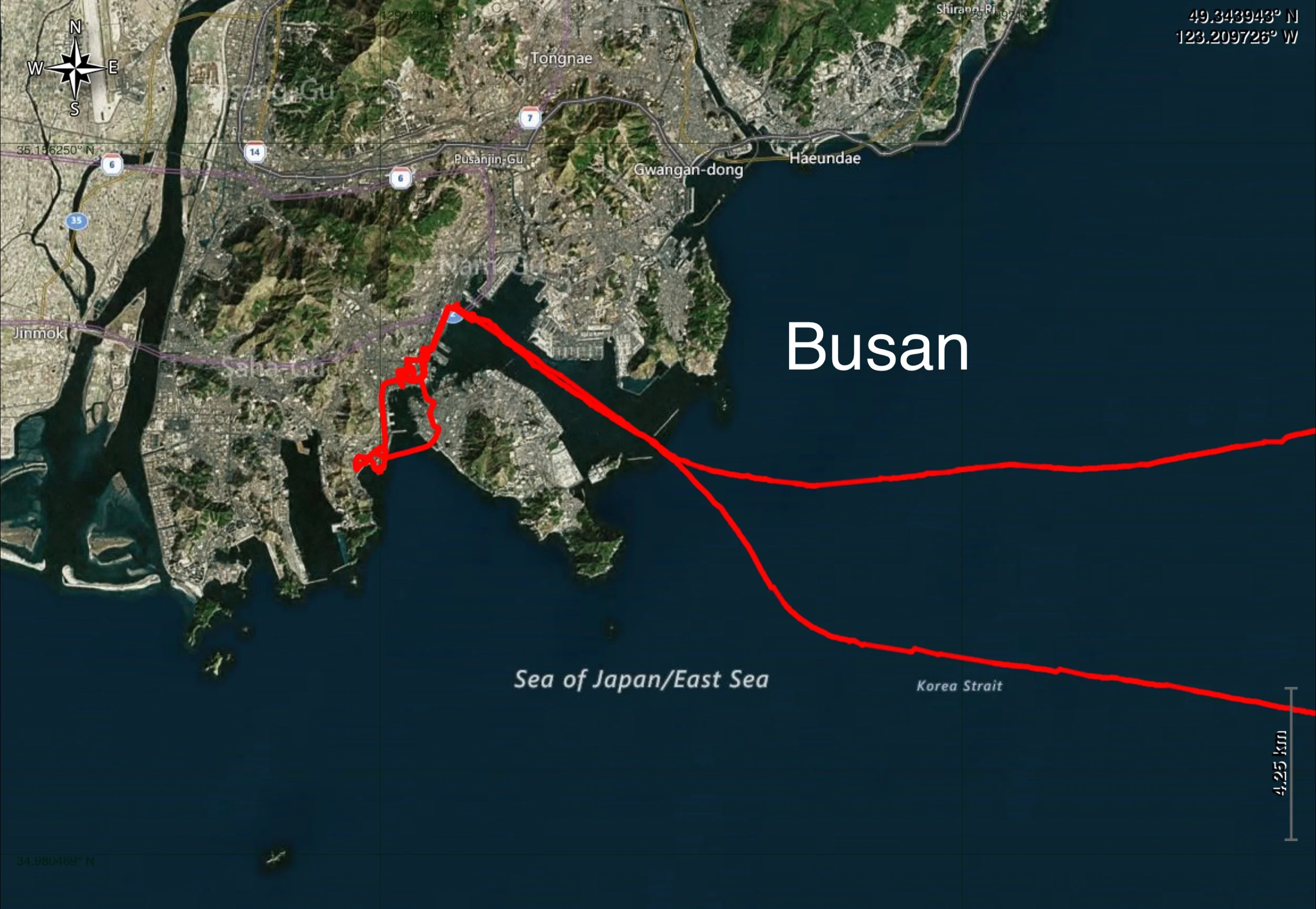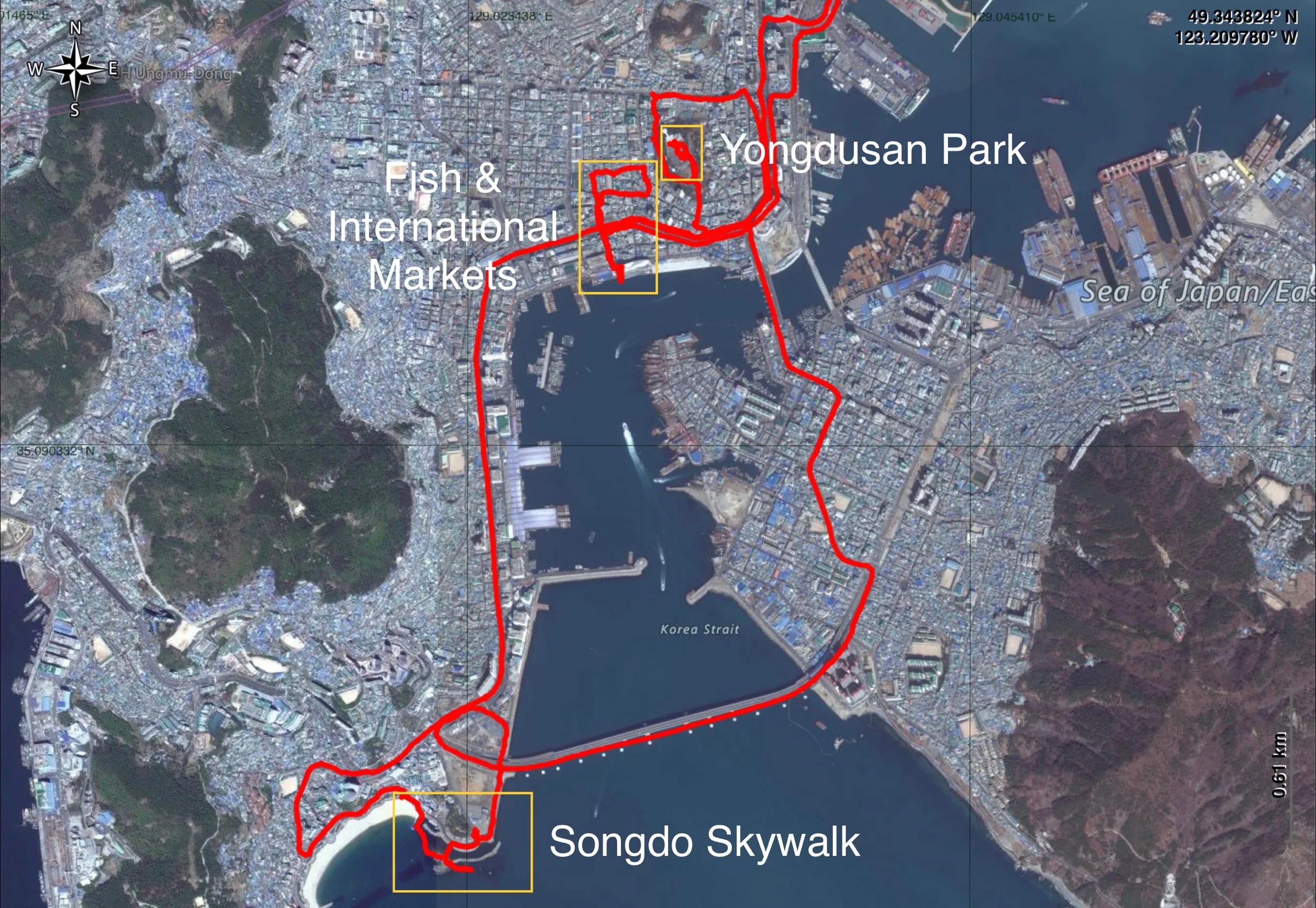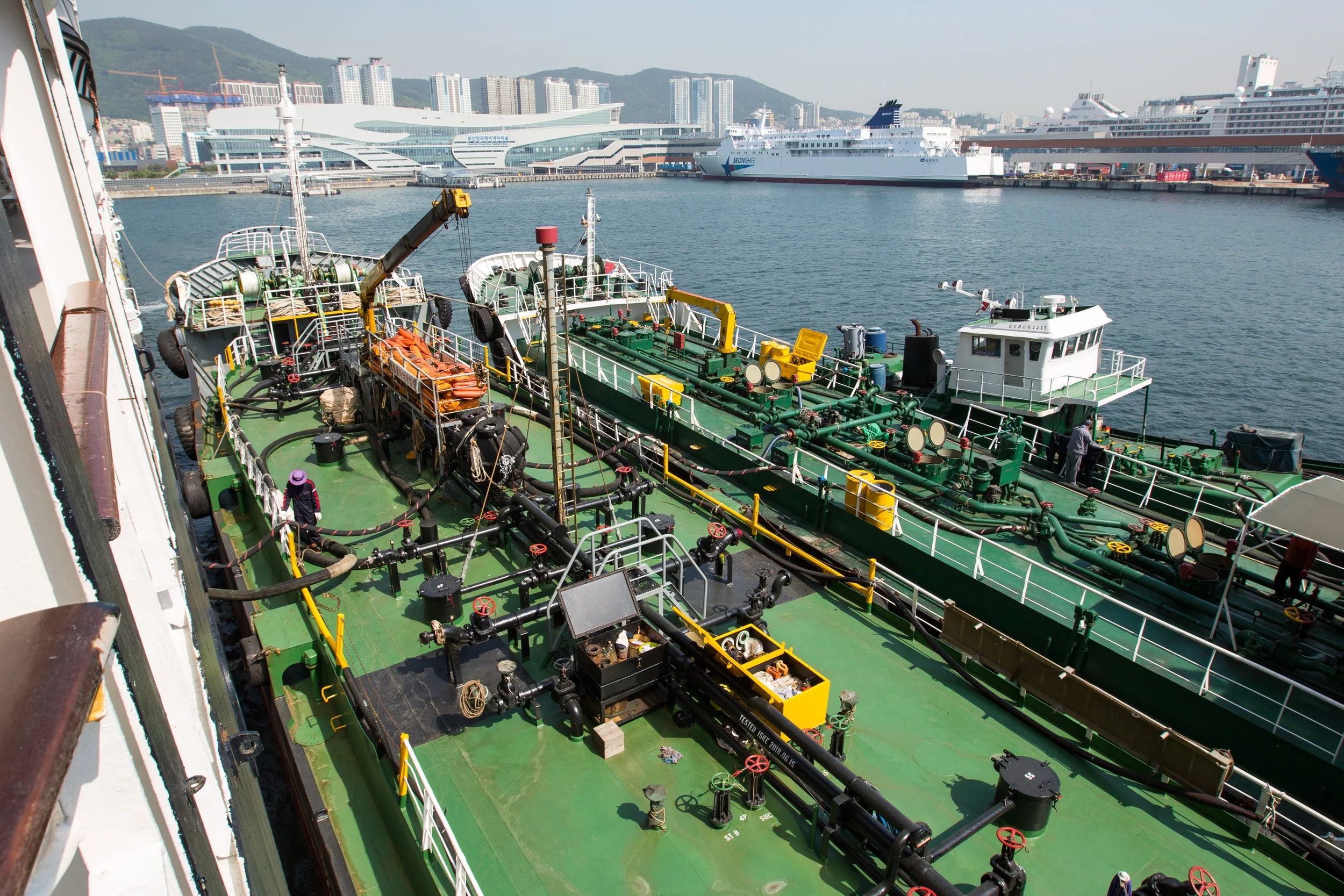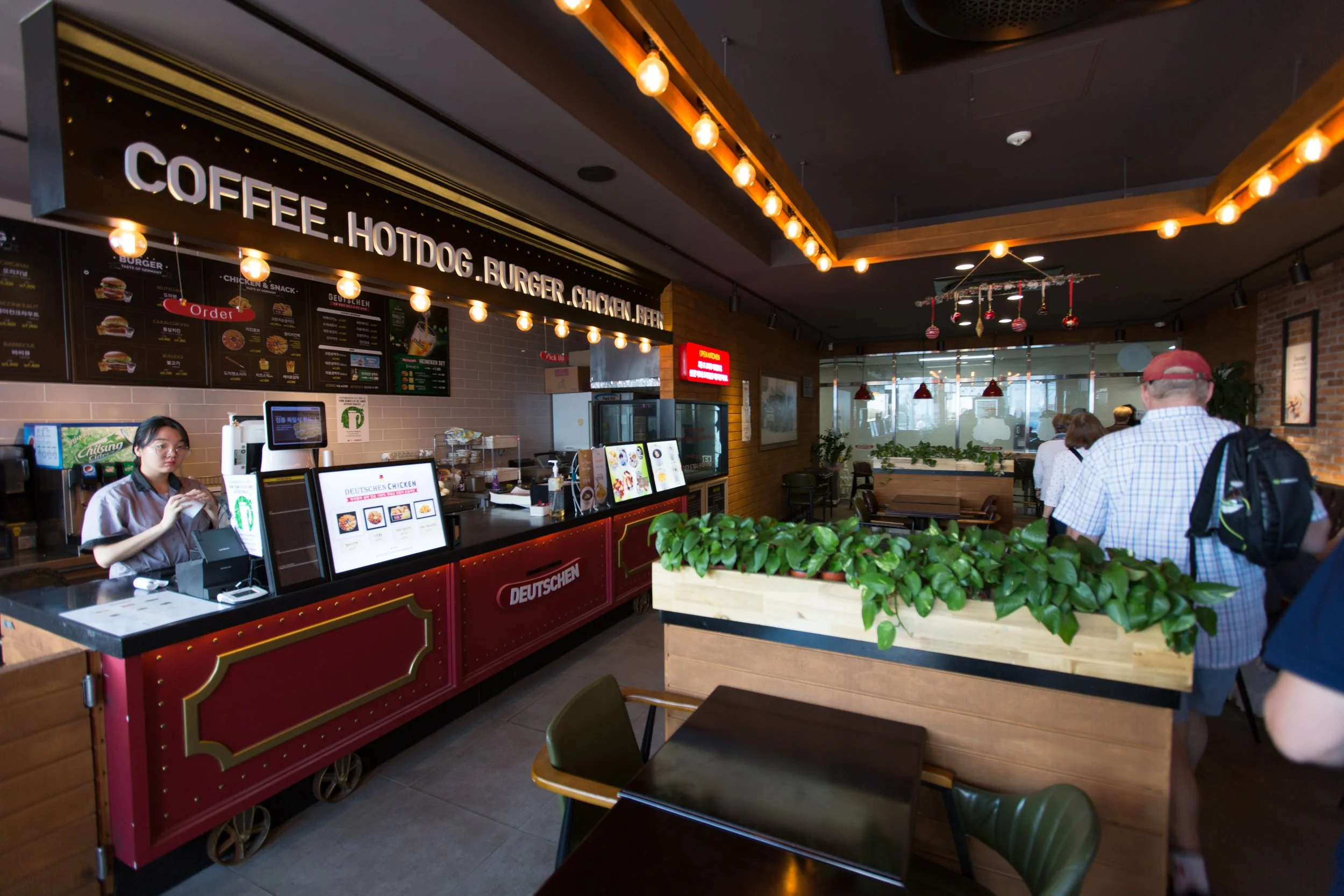Busan, South Korea
May 4, 2019
When we booked the cruise around Japan we were curious as to why the ship would cross the Straits of Tsushima, and the Korean Strait, both of which separate the Sea of Japan from the East China Sea, just to visit the city of Busan in South Korea. Once we arrived, however, it soon became evident what the reason was. It was all about money. Simply put, it was much cheaper to provision the ship and re-fuel its massive fuel tanks in South Korea, rather than the much more expensive Japan. Even the cost to motor the ship back and forth across the strait wasn’t enough to offset the savings. The bonus for us was that we got to see, albeit only for a day, another Asian country.
morning Arrival in Busan
Entering the port of Busan, South Korea.
The small vessel that delivered the harbour pilot to our ship for docking.
Busan is the second largest city in South Korea with a combined population (city and surrounding metro area) of around seven million people. Its because of this that it has a well developed and capable infrastructure, and it is this infrastructure that our ship needed to exploit in order to re-provision its stores and fuel.
While in port, the ship also took advantage of the technical equipment and personnel that were available, in order to facilitate a repair or upgrade to the ship’s equipment. Exactly what they did, we couldn’t determine. But it did require the use of a mobile crane.
Ship Provisions & Repair
Barely tied up and already they are starting to unload the supply trucks.
Within an hour of us tying up at the wharf in Busan, the ship was descended upon by a whole myriad of trucks, forklifts and of course, the massive crane. Provisioning would carry on all day while the ship’s guests were ashore on various excursions. We also weren’t able to see what the big crane was needed for, but it must have been something very heavy up on the top deck to require such a massive boom crane.
The other thing that amazed us was just how much fuel this ship could store. Much smaller than the giant cruise ships that carries several thousand passengers, ours only carried about six hundred. But nevertheless, it still took two bunkering vessels to fully fuel this supersized yacht.
Songdo Beach
One very uncrowded beach. Still, it was very early in the season, and quite chilly.
The first stop on our rather busy day for shore excursions was a beach right in the vast harbour area. Although we accessed it by tour bus, it could also be accessed from the other side of the harbour by overhead gondola.
Quite obviously one of the go-to locations for tourists in Busan, this particular sea-side area was awash in eye catching scenes and activities. With expensive tourist infrastructure, there were quite a lot of things one could do here to occupy their time. Our visit started with a walk out onto the very impressive elevated “boardwalk” constructed of aluminum and wood. As it was still fairly early, the crowds were light. But by the time we were walking back along the boardwalk the number of people had risen dramatically.
Busan Tower & Yongdusan Park
A view up from the bottom of Busan Tower. It would have been nice to gone up in it. But we had no time.
Our next stop on our tour of Busan was the aptly named Busan Tower. It’s a local tourist viewing tower similar to many around the world like the CN Tower in Toronto, Canada, the Space Needle in Seattle, U.S.A. or the Tokyo Skytree in Tokyo, Japan. Although it is of much smaller scale than any of the aforementioned examples. Still, it offers the opportunity for an impressive view of the surrounding area. Unfortunately, due to time constraints, we weren’t able to ascend the tower as the lineup would have taken too long.
What was of far more interest than the tower, however, was the cultural event that was taking place around Yongdusan Park which encompassed the tower. Hordes of people, all in spectacular costumes, were competing with each other for some ultimate prize. Although, just what the intended objective was, we never found out. We only had one tour guide per bus, and she was rarely around once we got off the bus.
This was our first hint that something was taking place. A small group of costumed people with a music system in the street.
But before we could experience the event that was taking place on the mountain top, we had to negotiate a considerable amount of city streets, on foot. The bus dropped us off on a main drag somewhere, and we had to walk and take a number of very long escalators to reach the final destination. Thank goodness it was still early in the day before the heat from the sunny weather had set in.
A Mysterious Cultural Event
Once we finally ascended to the top of the escalators and reached Yongdusan Park we were thrust into the middle of what was a sizeable cultural event, with thousands of people taking an active part in the festivities. It was almost like different regions of South Korea were being represented, and each one had a unique way to dress. Situated amid all of this finery, and perhaps central to it all, was a magnificent pavilion that you had to just marvel at. Known as the Citizen Bell Pavilion, it had an enormous bell, the sound from which must be amazing.
Citizens Bell Pavilion, with Busan Tower poking out above it.
Points of Interest In The Park
The tower with a coffee shop at its base. But everyone was watching the festivities.
Aside from the cultural festivities, there were other things of interest in the park which were more in keeping with typical tourist interests.
Besides Busan Tower, there were coffee shops and stores for people to explore. Also, positioned throughout the park were various statues and other art forms, some of which the visitors could interact with. One such work was a padlock rack where you could secure your personal “gift” to the people of Busan. These padlock placements have taken off all over the world. They were first simply fences or railings on bridges, like the ones we saw in Paris, France. But now these artistic monuments are being provided to try and save infrastructure from being compromised. In Paris they have begun cutting all the locks off the bridges because the shear volume of metal locks have become so heavy that they threaten the integrity of the civil structures.
Another attraction to the Yongdusan Park was quite simply the view from the top patio area in front of the tower. It was far reaching and provided an unobstructed view of the city clear out to the ocean.
The Fish Market
Once we had made our way by foot back down the mountain to the city streets, we waited at a predetermined spot for our bus to come and pick us up. Then it was off to the next stop of the day, the fish market by the harbour.
Like our previous stops, we were dropped off on a main street and had to hoof it through a number of back alleys in order to reach the waterfront where the fish market was located.
It was with a sense of curiosity, and perhaps also dread, that we visited this Asian fish market. We were aware that what we were about to experience was not something easily viewed by those who have a fondness for wild creatures of all types.
But we were here, and aside from just standing outside while the others toured the market, we really had no other option.
Before we even got inside the building, however, we had to pass by street vendors who were selling what they had to offer outside on the sidewalk. The odd one had “live” tanks with water, but most just had their product laid out on plates. From what we could see, there was no way of knowing if the product they were selling was fresh caught, or had been there for several days. It certainly wasn’t anything we’d want to buy. Then again, we’re not exactly experts on edible sealife.
After getting by all the street vendors, we made it to the back of the building where the wharf was, and the entrance to the main marketplace. What we experienced inside led us to wonder if there was any life left in the ocean at all. Every conceivable type of ocean fauna was crowded into tanks of all sizes, some with live creatures, but many with those that were not. It seemed nothing was off the menu.
The last section of the fish market.
After finishing the tour of the market inside the building, we left and came back outside. Off to one side of the building, but situated on the wharf, was yet another outside market selling even more sea life. But by this time we had had our fill, so to speak, and didn’t want to tour this remaining congested area. Fortunately, we had a bus to catch.
The International Market
This coffee bar chain always struck a bell with me because of its name. My father in his later years belonged to a CB radio club and his radio name was the Coffee Bean. And my mother’s was the Tea Leaf. This because my father was in the tea and coffee production business for fifty years.
After a short bus ride we were once again dropped off for a walking tour of what the city called the International Market. Considering every shop in every city around the world mostly sells products sourced from all over the planet, it seems kind of a redundant title. But nevertheless, we were here, and the tour company thought it worthy of our time, so we indulged them hoping we would find some unique treasure that would remind us of Busan. Sadly, we were overly optimistic.
A Food Court, of sorts
These look yummy. They use a lot of sugar here in things.
At one point in the tour around the international market area, we came across what in the western world would be called the food court. In this case, it was outdoors and you were serviced by carts rather than shops. They had quite a variety of things to choose from.
The Unexpected Parade
The parade was loud and bright.
As we were making our way back to our bus pick up location we happened upon a parade that was just setting up to start marching. Our tour guide phoned the bus driver and put him off for a while so we could stay and watch the parade. As appreciative as we were, it was getting late in the afternoon and our feet were starting to complain. But despite this, we persevered. But only because we just happened to end up waiting for the parade right in front of an ice cream shop. Needless to say, we fortified ourselves with sustenance from that store.
I guess Japanese people long to be like westerners. Why?
As odd as it may seem, the street that we were now on appeared to have a more international feel than the International Market that we had previously been touring. And they really went out of the way to make their point. It’s ironic, really, that the fashion and lifestyle accessories that are advertised as what’s mandatory to exude that image of western affluence, is actually manufactured here in their own backyard. In other words, they are paying ridiculous prices for products that they make locally. How bizarre is that.
Farewell to Busan
The view from the fantail of the ship, looking towards the hills with the Busan International Passenger Terminal Building to the right of the picture.
After what was a long and tiring day of scrambling all over the city, we finally made it back to the ship in time to relax and snarf down a great dinner on the fantail of our ship. From there we could see quite the panorama of a place we had spent less than twenty-four hours in. But before we left, it was allowed to get dark so we could see how pretty the harbour was at night. Yes, quite the pitstop for fuel and supplies.
Thanks, Busan, for a day filled with the sights and sounds of South Korea.


